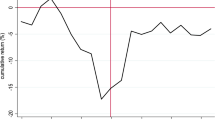Abstract
Economists generally assume that systems of transferable property rights are preferable to non-market systems. This paper suggests that the design of a market-based policy that dominates a command-andcontrol regime is more subtle than is commonly believed, even in theory. The subtlety arises because identical approaches to monitoring and enforcement will not generally yield the same results in different regulatory environments. The paper identifies conditions under which a kind of market dominance result obtains. The theory is then applied to the problem of trading rights to emit pollutants from motor vehicles.
Similar content being viewed by others
References
Becker, Gary, 1968. “Crime and Punishment: An Economic Approach.”Journal of Political Economy 77: 169–217.
Dales, John H. 1968.Pollution, Property and Prices. Toronto, Canada: University Press.
“Explanation of Why Fleet Averaging Would Allow More Auto Pollution.” 1989, undated, unpublished mimeo, circulated among the House of Representatives.
Hahn, Robert, 1984. “Market Power and Transferable Property Rights.”Quarterly Journal of Economics 99: 753–765.
Hahn, Robert, 1989.A Primer on Environmental Policy Design. London: Harwood Academic Publishers.
Hahn, Robert. 1990. “The Politics and Religion of Clean Air.”Regulation (Winter): 21–30.
Harford, John. 1978. “Firm Behavior Under Imperfectly Enforceable Pollution Standards and Taxes.”Journal of Environmental Economics and Management 5: 26–43.
Jones, Carol. 1990. “Standard Setting with Incomplete Enforcement Revisited.”Journal of Policy Analysis and Management 8: 72–87.
Jones, Carol and Suzanne Scotchmer. 1990. “The Social Cost of Uniform Regulatory Standards in a Hierarchical Government.”Journal of Environmental Economics and Management 19: 61–72.
Malueg, David, 1990. “Welfare Consequences of Emission Credit Trading Programs.”Journal of Environmental Economics and Management 18: 66–77.
Malik, Arun, 1990. “Markets for Pollution Control When Firms are Noncompliant.”Journal of Environmental Economics and Management 18: 97–106.
Misiolek, Walter and Harold Elder. 1989. “Exclusionary Manipulation of Markets for Pollution Rights.”Journal of Environmental Economics and Management 16: 156–166.
Montgomery, W. David. 1972. “Markets in Licenses and Efficient Pollution Control Programs.”Journal of Economic Theory 5: 395–418.
Noll, Roger 1982. “Implementing Marketable Emission Permits.”American Economic Review 72 (May): 120–124.
Oates, Wallace and Albert McGartland. 1985. “Marketable Pollution Permits and Acid Rain Externalities: A Comment and Some Further Evidence.”Canadian Journal of Economics XVIII: 668–675.
Oates, Wallace, Paul Portney, and Albert McGartland. 1985. “The Net Benefits of IncentiveBased Regulation: A Case Study of Environmental Standard Setting.”American Economic Review 79: 1233–1242.
Rubin, Jonathan and Cathy Kling, 1993. “An Emission Saved Is an Emission Earned: An Empirical Study of Emission Banking for Light Duty Vehicle Manufacturers.”Journal of Environmental Economics and Management 25: 257–274.
Stavins, Robert, ed. 1988.Project 88: Harnessing Market Forces to Protect Our Environment-Initiatives for the New President, a public policy study sponsored by Senator Timothy E. Wirth and Senator John Heinz, Washington, D.C.
Stavins, Robert, ed. 1991.Project 88-Round II, Incentives for Action: Implementing Market-Based Environmental Strategies, a public policy study sponsored by Senator Timothy E. Wirth and Senator John Heinz, Washington, D.C.
U.S. House of Representatives, Subcommittee on Health and the Environment. 1989. Hearing on Administration Proposal to Amend Clean Air Act, July 24, unpublished mimeo.
U.S. House of Representatives. 1990. “Clean Air Act Amendments of 1990.” Conference Report to accompany S. 1630,Report 101-952,101st Congress, second session, Government Printing Office, Washington, D.C.
Viscusi, W. Kip, and Richard Zeckhauser, 1979. “Optimal Standards with Incomplete Enforcement.”Public Policy 27: 437–456.
White, Lawrence J. 1982.The Regulation of Air Pollutant Emissions from Motor Vehicles. Washington, D.C.: American Enterprise Institute.
Author information
Authors and Affiliations
Additional information
Mr. Hahn is a Resident Scholar at the American Enterprise Institute and an Adjunct Professor of Economics at Carnegie University. Mr. Axtell is a Research Associate at the Brookings Institution. We would like to thank Linda Cohen, Glenn Loury, Eric Stork, and participants in the Harvard environmental economics workshop and the Stanford environmental economics conference for constructive comments. Jeff Alson, Richard Wilcox, and Don Zinger helped identify useful data sources. This research was supported in part by a grant from the National Science Foundation.
Rights and permissions
About this article
Cite this article
Hahn, R.W., Axtell, R.L. Reevaluating the relationship between transferable property rights and command-and-control regulation. J Regul Econ 8, 125–148 (1995). https://doi.org/10.1007/BF01072586
Issue Date:
DOI: https://doi.org/10.1007/BF01072586




